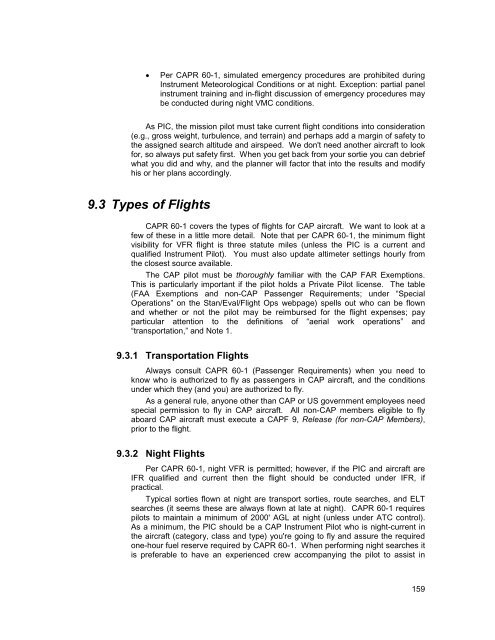MART Vol. II MO/MP - NESA - Civil Air Patrol
MART Vol. II MO/MP - NESA - Civil Air Patrol
MART Vol. II MO/MP - NESA - Civil Air Patrol
Create successful ePaper yourself
Turn your PDF publications into a flip-book with our unique Google optimized e-Paper software.
• Per CAPR 60-1, simulated emergency procedures are prohibited duringInstrument Meteorological Conditions or at night. Exception: partial panelinstrument training and in-flight discussion of emergency procedures maybe conducted during night VMC conditions.As PIC, the mission pilot must take current flight conditions into consideration(e.g., gross weight, turbulence, and terrain) and perhaps add a margin of safety tothe assigned search altitude and airspeed. We don't need another aircraft to lookfor, so always put safety first. When you get back from your sortie you can debriefwhat you did and why, and the planner will factor that into the results and modifyhis or her plans accordingly.9.3 Types of FlightsCAPR 60-1 covers the types of flights for CAP aircraft. We want to look at afew of these in a little more detail. Note that per CAPR 60-1, the minimum flightvisibility for VFR flight is three statute miles (unless the PIC is a current andqualified Instrument Pilot). You must also update altimeter settings hourly fromthe closest source available.The CAP pilot must be thoroughly familiar with the CAP FAR Exemptions.This is particularly important if the pilot holds a Private Pilot license. The table(FAA Exemptions and non-CAP Passenger Requirements; under “SpecialOperations” on the Stan/Eval/Flight Ops webpage) spells out who can be flownand whether or not the pilot may be reimbursed for the flight expenses; payparticular attention to the definitions of “aerial work operations” and“transportation,” and Note 1.9.3.1 Transportation FlightsAlways consult CAPR 60-1 (Passenger Requirements) when you need toknow who is authorized to fly as passengers in CAP aircraft, and the conditionsunder which they (and you) are authorized to fly.As a general rule, anyone other than CAP or US government employees needspecial permission to fly in CAP aircraft. All non-CAP members eligible to flyaboard CAP aircraft must execute a CAPF 9, Release (for non-CAP Members),prior to the flight.9.3.2 Night FlightsPer CAPR 60-1, night VFR is permitted; however, if the PIC and aircraft areIFR qualified and current then the flight should be conducted under IFR, ifpractical.Typical sorties flown at night are transport sorties, route searches, and ELTsearches (it seems these are always flown at late at night). CAPR 60-1 requirespilots to maintain a minimum of 2000' AGL at night (unless under ATC control).As a minimum, the PIC should be a CAP Instrument Pilot who is night-current inthe aircraft (category, class and type) you're going to fly and assure the requiredone-hour fuel reserve required by CAPR 60-1. When performing night searches itis preferable to have an experienced crew accompanying the pilot to assist in159














